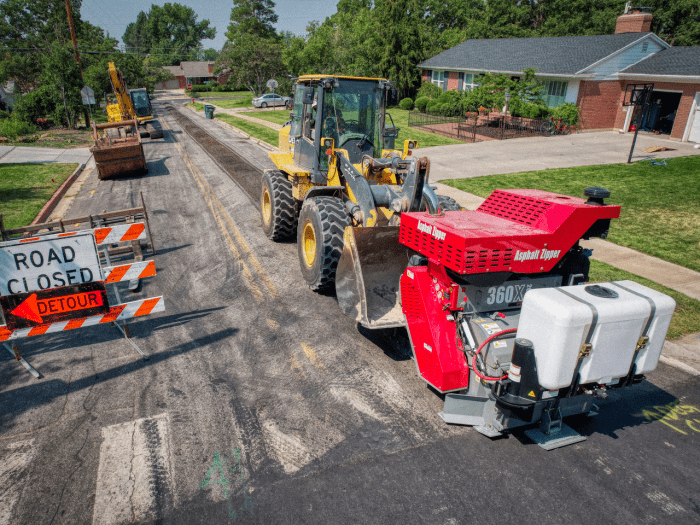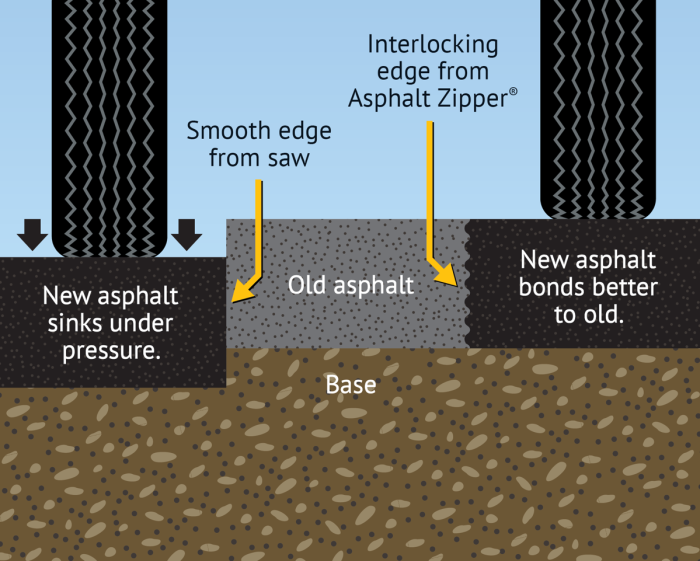Opening utility trench in asphalt with an asphalt grinder involves many steps. Basis safety rules and good asphalt patching are just a few parts of an underground utility project.
Traffic control and avoiding inconvenience to businesses and residents is important. You will need to consider future maintenance on the asphalt surfaces. Here are a few of the best practices to keep in mind when opening utility trench in asphalt.
Safety During Utility Trenching

Utility companies implement safety measures to protect the workforce and public on the job site when opening utility trench. It is important to keep workers safe with proper personal protective equipment (PPE). This includes hard hats, safety glasses, and hearing protection.
When you use an asphalt grinder, keep the public at a safe distance. Clearly marking the work area with barriers and warning signs keeps residents safe. Asphalt grinders get dusty and you might also need to use dust control systems.
Here are some OSHA guidelines for underground utility projects:
- Utility trenches 5 feet deep or deeper need a protective system. These include benching, sloping, shoring, or shielding.
- Keep heavy equipment away from the utility trench edges.
- Locate existing underground water lines, gas lines and other utility pipelines before you dig.
- Test for low oxygen, fumes or toxic gasses on construction sites if the utility trench is greater than 4 feet deep.
- Do not work under suspended loads.
- Wear high visibility clothing.
Minimize Disruptions During Asphalt Removal
Asphalt removal can be a time consuming process that disturbs businesses and residents. Using an asphalt grinder helps this problem by getting the job done more quickly. It is also a more cost effective way to open utility trench in asphalt.
With an asphalt grinder, you can open utility trench that used to take 18 plus hours in about an hour. Compared to chunking asphalt, this is much less labor intensive. Also, as soon as you finish the asphalt removal, cars can drive over the asphalt grindings into parking lots or driveways. This lets people get where they need to go no matter the duration of the project.
Plan underground utility pipeline projects to avoid peak business hours. In house asphalt removal with an asphalt milling machine or asphalt grinder gives you more scheduling flexibility. Also, provide clear and frequent updates.
Best Asphalt Patching Practices

You may have pavement patching specs on your underground utility project. Asphalt removal with an asphalt grinder scarifies the edge of the cut asphalt. The scarified edge binds the old asphalt with the new. This helps to prevent utility trench settling.
Asphalt grinding machines can also produce spec comparable trench backfill material. Proper compaction of the asphalt millings or trench back fill is also important.
Some projects require t-patching of utility trenches. An asphalt grinder removes a few inches of asphalt on each side of the utility trench. After you pave the utility trench and surrounding asphalt, the result is a t section of asphalt.
With a t-section patch, your trench joints are at different levels. This makes it difficult for water to damage the asphalt patch. It also helps with trench settling.
Minimize Future Asphalt Maintenance
There are a few things you can do to limit asphalt repair costs after patching a utility trench. First, when you patch asphalt, use high-quality materials and follow industry standards. This will help your pavement last longer.
Good trench compaction reduces settling and future cracking. Apply a sealant to the patched area to protect against water infiltration and further damage.
Regularly inspect and maintain the patched area, addressing any issues promptly. Implement a preventive maintenance plan for the entire asphalt pavement, which includes the patched trench, to catch and fix problems early. Lastly, educate utility workers and contractors on best practices to prevent future damage during utility trench maintenance.
Summing it Up
Opening utility trenches in asphalt with an asphalt grinder or asphalt milling machine involves several crucial considerations. First, make sure workers wear proper protective gear and control dust to prevent health problems and prioritize safety. Clearly mark work areas to keep the public at a safe distance and adhere to OSHA guidelines for utility trench safety. Speed is key in lessening inconvenience to businesses and residents. Use asphalt grinders for faster pipe trench opening. Coordination with local businesses to avoid peak hours is essential. Clear pedestrian pathways and open communication is important too.